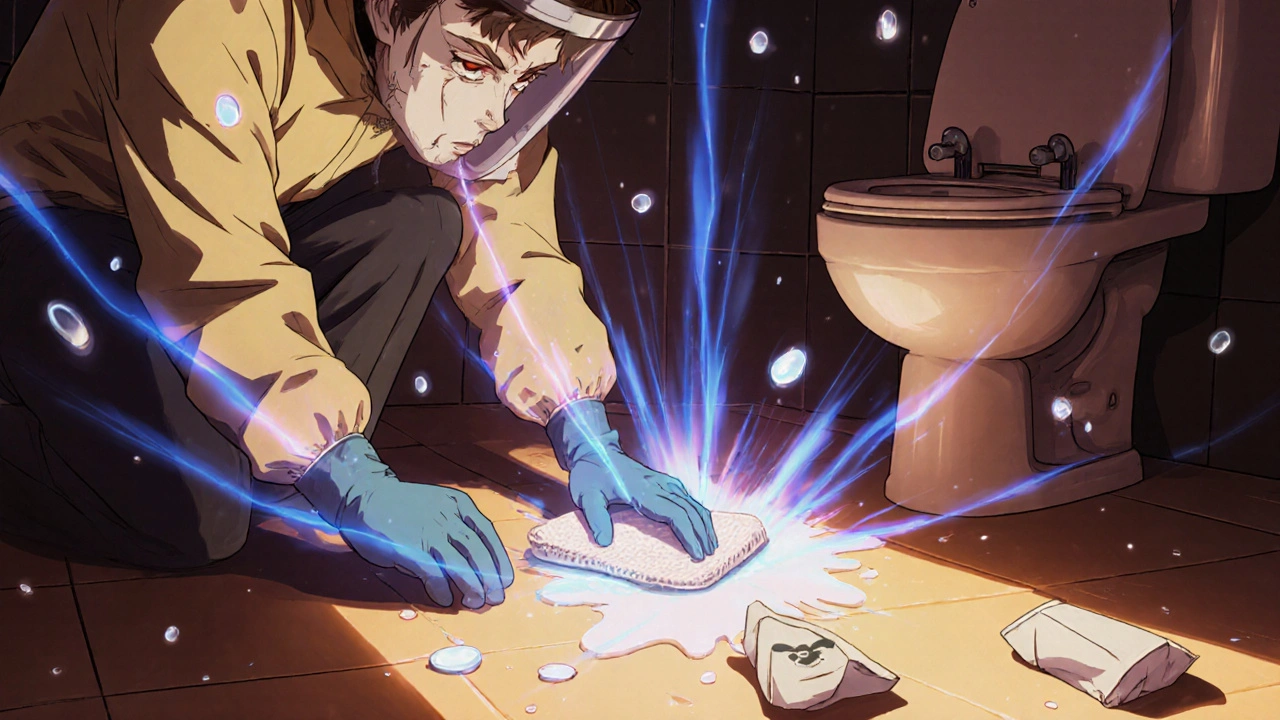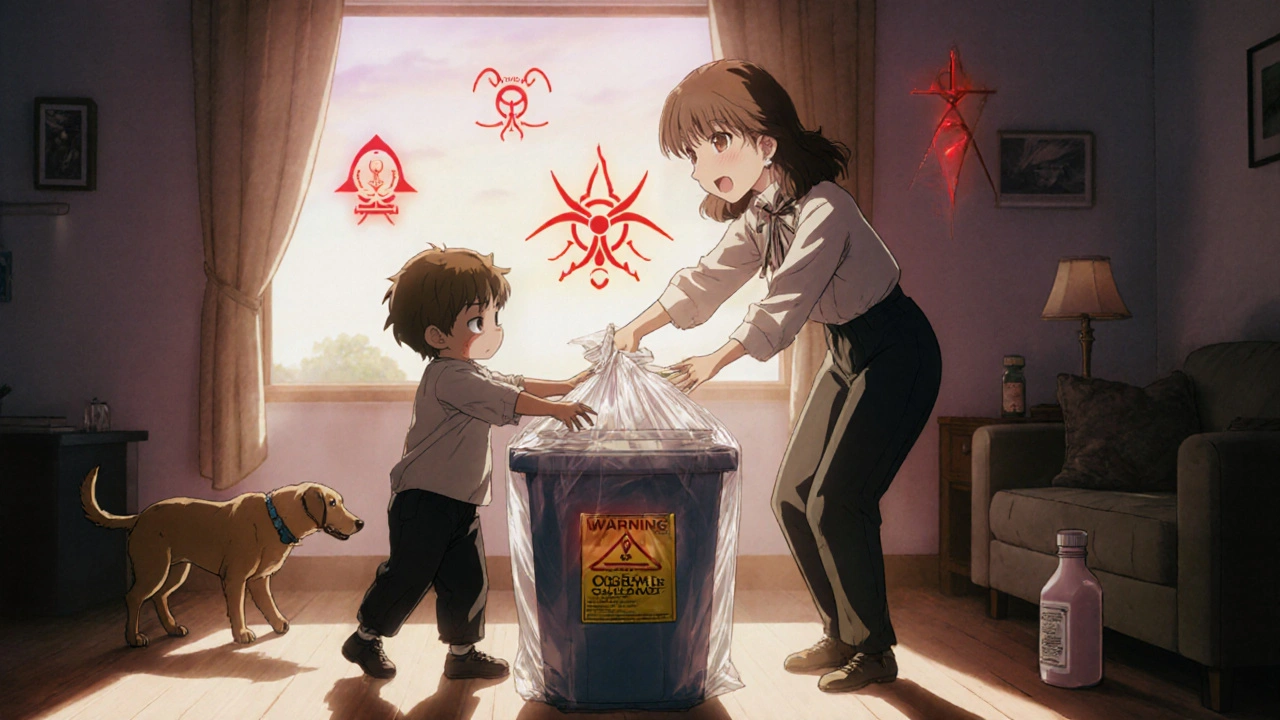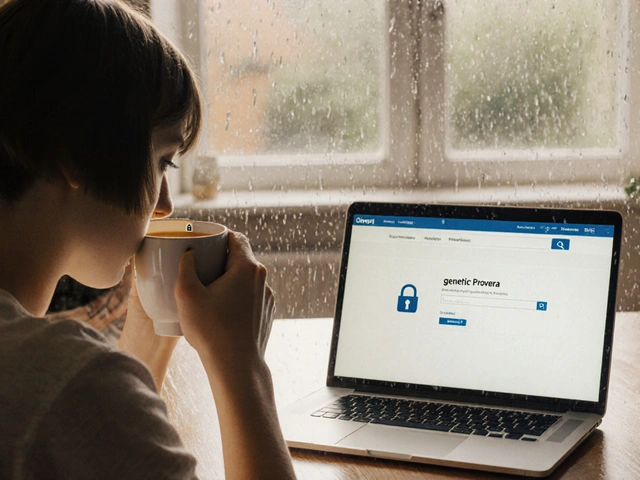Why Chemotherapy Medication Can’t Be Thrown in the Trash Like Regular Pills
When you take a regular painkiller or antibiotic at home, you can toss the empty bottle or leftover pills in the trash with little worry. But chemotherapy drugs? Those are different. They’re not just strong-they’re dangerous. Even tiny amounts left on gloves, in urine, or on a pill bottle can harm children, pets, or waste workers. These drugs are designed to kill fast-growing cells, which is why they work against cancer. But they don’t know the difference between cancer cells and healthy ones. That’s why even a small spill or improper disposal can cause serious health risks.
The American Cancer Society says chemotherapy drugs can stay active in your body for up to 72 hours after you take them. That means your sweat, vomit, urine, and even bowel movements can carry traces of the drug. If you flush them down the toilet, pour them down the sink, or throw them in a regular trash bag, you’re putting your family, your neighbors, and the environment at risk. The EPA found detectable levels of cyclophosphamide-a common chemo drug-in two out of three U.S. waterways. That’s not a myth. That’s science.
What You Need Before You Start
Before you even think about disposing of chemotherapy medication, make sure you have the right supplies. Most oncology clinics give these to you when they start your home treatment, but if you’re running low, ask for more. Here’s what you need:
- Disposable nitrile gloves (0.07-0.15mm thick)-not latex or household gloves. These protect your skin from absorbing the drug.
- Two leak-proof plastic bags-each at least 1.5 mil thick. These aren’t grocery bags. They’re specially designed for hazardous waste.
- A yellow hazardous waste container (if provided by your clinic)-this is for solid items like used syringes, IV bags, or empty pill bottles.
- Sealable zip-ties or heat-sealing tools-to make sure the inner bag doesn’t leak.
- Dedicated cleaning cloths and disinfectant-never use kitchen towels or household cleaners for chemo spills.
Don’t skip the gloves. A 2021 safety study from Mayo Clinic showed that proper glove use cuts skin exposure by over 90%. And never reuse gloves. Even if they look clean, the chemicals don’t wash off easily.
How to Dispose of Different Types of Chemotherapy Medications
Not all chemo drugs are the same. How you dispose of them depends on the form. Here’s what to do for each type:
Oral Pills and Capsules
Never crush, chew, or dissolve pills. That releases the drug into the air and makes it harder to contain. Instead:
- Wear gloves.
- Place unused or expired pills directly into the inner leak-proof bag.
- Seal the bag tightly with a zip-tie.
- Place it inside the second bag and seal that one too.
- Label the outer bag: “Hazardous Chemotherapy Waste-Do Not Open.”
Even if the pill bottle is empty, put it in the same double-bagged system. Residue can cling to the plastic.
Transdermal Patches (Skin Patches)
These are tricky. The drug is still active even after you peel them off. Here’s the correct way:
- Wear gloves.
- Fold the patch so the sticky side sticks to itself. This traps the drug inside.
- Place it in the inner bag.
- Double-bag and label as above.
Never throw a patch in the trash unfolded. Someone could touch the sticky side and get exposed.
Liquid Medications and IV Bags
These are the most dangerous. A spill can soak into a carpet or floor. Always have a spill kit ready.
- For unused liquid: Pour it into a disposable cup, then add an absorbent material like kitty litter, sawdust, or coffee grounds. Stir it until the liquid is fully soaked.
- Place the mixture into the inner bag, seal it, then double-bag.
- For IV bags or tubing: Cut them open (with gloves) to drain any remaining fluid into a container with absorbent material. Then place everything in the inner bag.
What About Bodily Waste?
You might think, “I’m not disposing of the drug-I’m just peeing.” But here’s the truth: your body doesn’t break down all of it. Up to 72 hours after your dose, your urine, feces, and vomit can still contain active chemo drugs.
Here’s what to do:
- Flush the toilet twice after each use.
- Wipe the toilet seat and handle with disinfectant after each use.
- Wash your hands thoroughly with soap and water-don’t just rinse.
- If you’re vomiting, use disposable cloths and gloves. Place everything in the hazardous waste bag.
Use a separate bathroom if you can. If not, clean surfaces immediately after use. Don’t let kids or pets near the toilet for at least 48 hours after your treatment.

What NOT to Do
These are common mistakes-don’t make them:
- Don’t flush. Even if the label says “flush if no take-back program,” that rule doesn’t apply to chemotherapy. The FDA says no chemo drug should ever be flushed.
- Don’t use Deterra® or similar deactivation systems. Their website clearly states they’re not approved for chemotherapy.
- Don’t put it in a regular trash bag. Single-bag disposal increases exposure risk by 92%, according to Mayo Clinic.
- Don’t reuse gloves or containers. Even if they look clean, they’re contaminated.
- Don’t wait until the bottle is empty. Dispose of unused meds immediately after your treatment ends.
What If You Have a Spill?
Spills happen. A dropped pill, a leaky bag, a splash of liquid-it’s stressful, but you can handle it safely.
Follow this 15-step procedure from the Cancer Institute of New Jersey:
- Put on gloves, gown, face shield, and mask.
- Block off the area-keep people and pets away.
- Use absorbent pads or paper towels to soak up the spill.
- Place all used materials into the inner hazardous waste bag.
- Wipe the area with a disinfectant approved for cytotoxic spills.
- Rinse the cloth with water and dispose of it in the same bag.
- Wash your hands thoroughly.
- Double-bag everything.
- Label the bag clearly.
- Notify your oncology team about the spill.
- Document the date, time, and cleanup steps.
- Replace any used supplies.
- Monitor yourself for skin irritation or nausea in the next 24 hours.
- If you feel unwell, call your doctor immediately.
Most clinics provide spill kits. If you don’t have one, ask for one. It’s not optional-it’s essential.
Can You Use a Take-Back Program?
Yes-but only in limited cases. The MedDrop kiosks at some pharmacies accept certain chemotherapy drugs, but only 63% of them are eligible. The rest? They’re too hazardous. And only 34% of U.S. pharmacies even offer chemo take-back services.
Mail-back programs exist, but only 28% of pharmacies provide them for chemo waste. Community events? Only 12% accept chemotherapy because of the extra safety steps needed.
Bottom line: Don’t rely on take-back programs. Most of the time, you’ll need to dispose of it at home using the double-bag method. That’s why your clinic should give you enough bags and gloves for the full treatment cycle.
How Long Do You Keep the Precautions?
You can’t stop being careful the day after your treatment. The Cancer Institute of New Jersey and the American Cancer Society both say: continue safety steps for 48 to 72 hours after your last dose. That means:
- Wear gloves when handling any used items.
- Double-bag all waste.
- Flush twice after using the toilet.
- Wash laundry separately if it’s been contaminated.
Some drugs, like cyclophosphamide, can remain in your system for up to 7 days. If you’re unsure, ask your nurse. Keep the disposal rules active until you’re told otherwise.

What Happens to the Waste After You Dispose of It?
When you double-bag your chemo waste and put it in the regular trash, it doesn’t go to a landfill like your old socks. In most areas, hazardous medical waste is collected separately and taken to special incineration facilities. These burn the waste at temperatures over 1,800°F, which breaks down the chemicals into harmless compounds.
But if you don’t double-bag it? That waste could end up in a regular landfill. Rainwater can wash the chemicals into groundwater. Workers sorting trash could get exposed. Pets could chew on a pill bottle. That’s why proper disposal isn’t just about rules-it’s about protecting people you’ll never meet.
Why So Many People Get It Wrong
A 2023 study in the Journal of Oncology Practice found that only 53% of patients consistently follow the right disposal steps. Why? Because it’s complicated. Most people get one training session from a nurse, then forget. The instructions are often unclear. One survey found that only 30% of patients felt confident they were doing it right.
Here’s the fix: Ask for a printed checklist. Ask for a video demo. Ask your nurse to watch you do it once. Don’t assume you remember. This isn’t like taking a pill. One mistake can have long-term consequences.
What’s Changing in 2025
Things are improving. In March 2023, the FDA required all oral chemotherapy drugs to include clear disposal instructions on their labels. That affects over 147 medications. The EPA has also allocated $4.7 million to research better disposal methods by 2026.
New technologies are coming too. The ChemiSafe disposal system and the Oncology Waste Management Unit are both under FDA review. These could make home disposal safer and simpler within the next two years.
But for now? The rules haven’t changed. Double-bag. Wear gloves. Don’t flush. Don’t guess.
Final Checklist for Safe Chemo Disposal
- ☐ Wear gloves every time you handle medication or waste
- ☐ Never crush, chew, or dissolve pills
- ☐ Fold patches sticky-side in
- ☐ Absorb liquids with kitty litter or coffee grounds
- ☐ Double-bag all waste-inner and outer sealed bags
- ☐ Label bags: “Hazardous Chemotherapy Waste”
- ☐ Flush toilet twice after use
- ☐ Clean surfaces after each use
- ☐ Keep precautions for 48-72 hours after last dose
- ☐ Never use Deterra® or flush chemo drugs
- ☐ Call your oncology team if you’re unsure
If you follow this checklist, you’re not just following rules-you’re protecting your family, your community, and the environment. That’s worth the extra step.
Can I flush chemotherapy drugs down the toilet if there’s no take-back program?
No. Even if the FDA allows flushing for some painkillers or antidepressants, chemotherapy drugs are never included. Flushing chemo meds contaminates water systems and can harm aquatic life and drinking water supplies. The EPA and FDA both prohibit flushing chemotherapy drugs under any circumstances.
What if I don’t have the special yellow hazardous waste container?
You don’t need it for every item. The yellow container is mainly for sharps like needles or IV tubing. For pills, patches, or empty bottles, double-bagging in two leak-proof plastic bags is sufficient. If you’re unsure, call your oncology nurse-they can send you replacements or arrange pickup.
Can I put chemo waste in the recycling bin?
Never. Chemo-contaminated items-even empty bottles-must go in the hazardous waste bag. Recycling facilities aren’t equipped to handle toxic substances. Mixing them with recyclables puts workers at risk and can contaminate entire batches of recycling.
How do I dispose of chemo waste if I live in an apartment?
The same rules apply. Double-bag your waste and place it in your regular household trash. Most apartment complexes don’t have special medical waste collection, so you’ll need to follow home disposal guidelines. If you’re concerned about storage, keep the sealed bags in a locked cabinet until trash day.
Are there any free disposal programs for chemotherapy waste?
Some nonprofit organizations and cancer centers offer free mail-back kits or pickup services for chemotherapy waste. Ask your oncology team-they often have partnerships with companies like Stericycle. In some states, Medicaid or Medicare may cover disposal supplies. Always check with your provider before paying out of pocket.





Sheldon Bazinga - 20 November 2025
lol so now i gotta wear gloves to pee? next they'll make me disinfect my farts. this is why america's going to shit.
Mark Kahn - 21 November 2025
this is actually super helpful. my aunt just started chemo and i was terrified i'd mess up. double-bagging makes sense. thanks for laying it out so clear.
Anne Nylander - 22 November 2025
omg thank you!! i was gonna throw the patch in the trash like a dummy. you just saved my dog from a nightmare 💕
Logan Romine - 24 November 2025
so we're told not to flush... but the FDA says flush for antidepressants? so chemo is more dangerous than suicidal thoughts? 🤔 the logic here is... poetic.
Noah Fitzsimmons - 25 November 2025
you know what's worse than chemo waste? people who think they're heroes for following instructions. congrats, you didn't poison your kid. big deal.
Pravin Manani - 26 November 2025
the pharmacokinetics of cytotoxic agents in bodily fluids are often underestimated. even trace concentrations of cyclophosphamide metabolites can induce genotoxic effects in aquatic organisms via bioaccumulation. this protocol is not merely precautionary-it's ecological imperative.
Leo Tamisch - 26 November 2025
so i'm supposed to believe that a $2 plastic bag is the barrier between my neighbor's water supply and a carcinogenic apocalypse? we're treating cancer patients like nuclear waste handlers now. where's the dignity?
Cooper Long - 27 November 2025
The protocol outlined herein is both scientifically sound and ethically necessary. Failure to adhere to double-bagging procedures constitutes a breach of public health standards. The EPA data cited is unequivocal.
Sandi Moon - 28 November 2025
You realize the government has been quietly dumping chemo waste into landfills for decades under the guise of 'incineration'? The 'special facilities' are a myth. They burn it and call it 'clean'. The smoke? It goes into your air. The ash? It ends up in your soil. They don't want you to know this.
Kartik Singhal - 29 November 2025
so like... if i double bag it and put it in the trash... but my building has a compactor... what then? 🤡💀
Chris Vere - 30 November 2025
the body is not an enemy. the drugs are not the enemy. the fear is the enemy. we treat cancer like a war and then we treat the survivors like weapons of mass destruction. we need to change the story
Franck Emma - 1 December 2025
I just spent 3 hours double-bagging my husband's pills. I'm exhausted. And now I'm crying. This isn't medicine. This is torture.
Daisy L - 1 December 2025
I can't believe people still think flushing is okay!!! Are you people insane?!?!?! This isn't a suggestion-it's a LAW! And if you don't follow it, you're not just irresponsible-you're a menace!!!